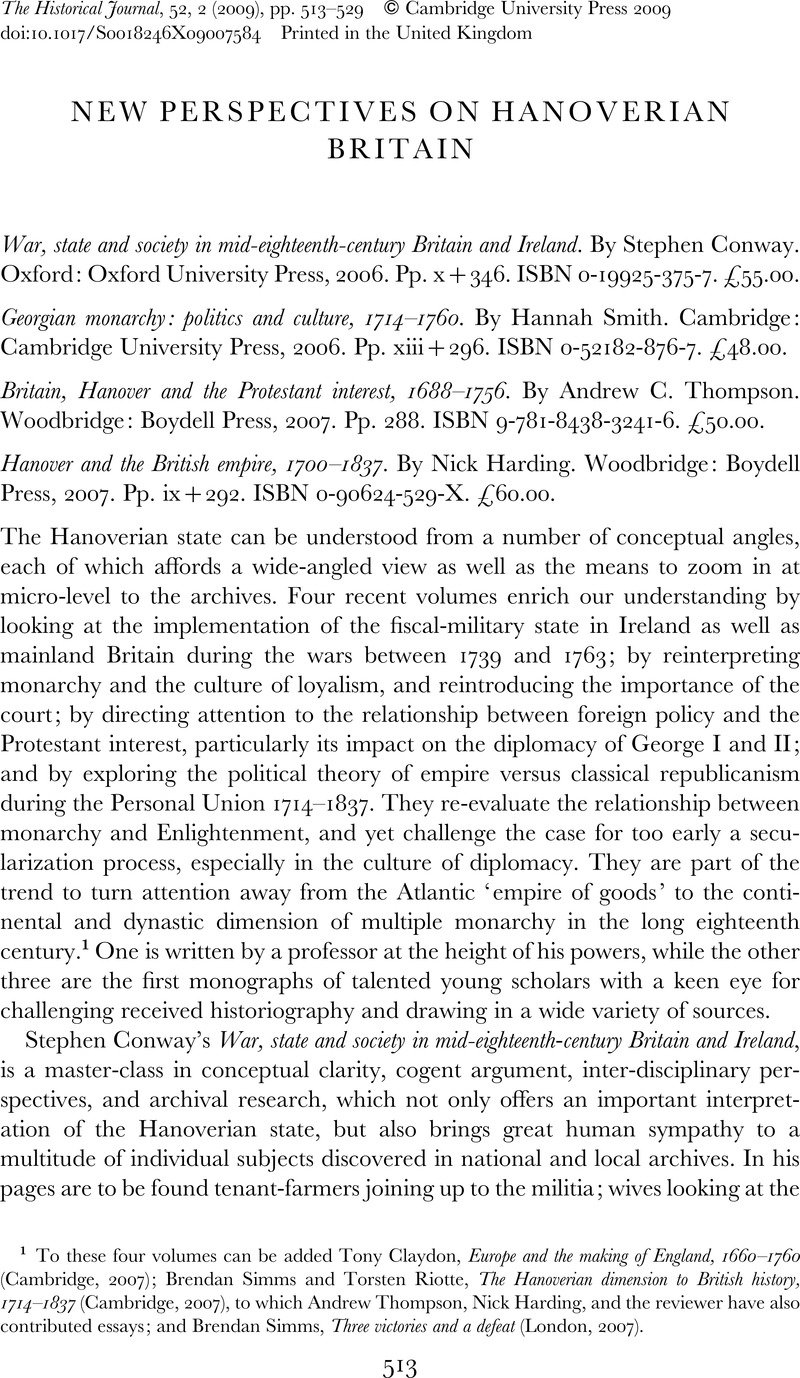No CrossRef data available.
Article contents
NEW PERSPECTIVES ON HANOVERIAN BRITAIN
Published online by Cambridge University Press: 15 May 2009
Abstract

- Type
- Review Articles
- Information
- Copyright
- Copyright © Cambridge University Press 2009
References
1 To these four volumes can be added Tony Claydon, Europe and the making of England, 1660–1760 (Cambridge, 2007); Brendan Simms and Torsten Riotte, The Hanoverian dimension to British history, 1714–1837 (Cambridge, 2007), to which Andrew Thompson, Nick Harding, and the reviewer have also contributed essays; and Brendan Simms, Three victories and a defeat (London, 2007).
2 E.g. Philip Carter, Men and the emergence of polite society, Britain 1660–1800 (Harlow, 2001).
3 Private communication; see also R. O. Bucholz, The Augustan court: Queen Anne and the decline of court culture (Stanford, CA, 1993).
4 Philip Woodfine, Britannia's glories: the Walpole ministry and the 1739 war with Spain (Woodbridge, 1998), pp. 129–30.
5 Admiral Boscawen to Mrs Montagu, 6 Nov. 1756, in Elizabeth Montagu, the queen of the bluestockings, her correspondence from 1720–1761, by her great-niece Emily J. Climenson (2 vols., London, 1906), ii, pp. 95–6.
6 Lewis Namier and John Brooke, eds., The House of Commons, 1754–1790 (3 vols., London, 1985), iii, p. 75.
7 Information on the Boscawens has been collated from Oxford Dictionary of National Biography (2004–8 online); Romney Sedgwick, ed., The House of Commons, 1715–1754 (3 vols., London, 1970); Database of court officers 1660–1837, /www.luc.edu/history/fac_resources/bucholz/DCO/DCO.html; Office-holders in modern Britain, www.ihrinfo.ac.uk/office; Cecil Aspinall-Oglander, Admiral's wife, being the life and letters of the Hon. Mrs Edward Boscawen from 1719–1761 (London, 1940).
8 N. A. M. Rodger, The insatiable earl: a life of John Montagu, fourth earl of Sandwich, 1718–1792, insatiable earl (London, 1993).
9 Stephen Conway, review of George II: puppet of the politicians?, Jeremy Black (review no. 659): www.history.ac.uk/reviews/paper/conway2.html, accessed 8 May 2008.
10 Unlike Sellars and Yeatman's Cavaliers – wrong but romantic.
11 A foretaste is provided by Joanna Marschner, ‘Queen Caroline of Anspach and the European princely museum tradition’, in C. Campbell Orr, ed., Queenship in Britain: royal patronage, court culture and dynastic politics, 1660–1837 (Manchester, 2002).
12 Holger Hoock, The king's artists: the Royal Academy of Arts and the politics of British culture, 1760–1840 (Oxford, 2003).
13 Jeremy Black, George II: puppet of the politicians? (Exeter, 2007).
14 Susanne Groom and Lee Prosser, Kew Palace: the official illustrated history (London, 2006), pp. 44–55; Frances Vivian, A life of Frederick, prince of Wales, 1707–1751: a connoisseur of the arts, ed. Roger White (Lampeter, 2006); Veronica P. M. Baker-Smith, Royal discord: the children of George II (London, 2008); idem, A life of Anne of Hanover, Princess Royal (Leiden, 1995).
15 This point was debated between Torsten Riotte and Andrew Thompson in Torsten Riotte, review of Andrew C. Thompson, Britain, Hanover and the Protestant interest, 1688–1756 (review no. 628): www.history.ac.uk/reviews/paper/riotte.html, accessed 1 Nov. 2007.
16 Abigail Green, Fatherlands, state-building and nationhood in nineteenth-century Germany (Cambridge, 2001).


